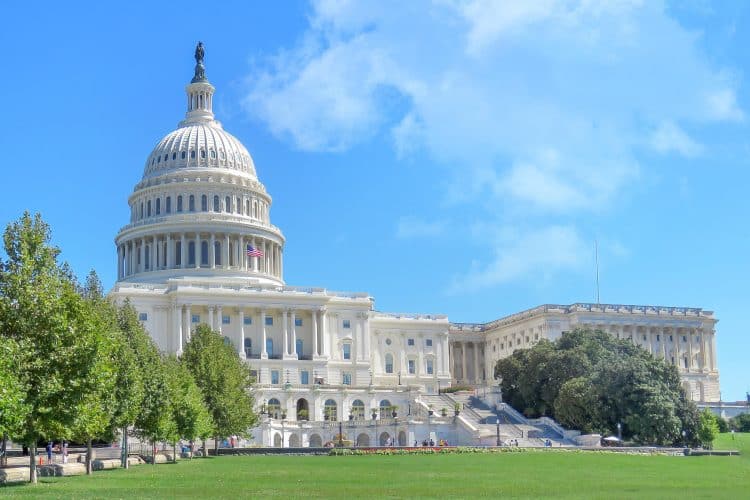A look at some of what shed businesses can take advantage of in the legislation signed into law on July 4.

On July 4, President Donald Trump signed the “One Big Beautiful Bill Act” into law.
The statute, passed by the 119th Congress, contains the president’s tax and spending policies for his second term in office.
The act contains hundreds of provisions, and it has significant implications for business owners around the country, including those owners in the shed industry.
Jeff Brabant is vice president of federal government relations for the National Federation of Independent Business (NFIB). He explored several provisions during the webinar “The One Big Beautiful Bill Act: What’s in it and why small business owners should care.”
(Note: This article is for information only. For advice relating to your specific situation, consult your CPA or other tax professional.)
SMALL BUSINESS TAX DEDUCTION
Brabant says that small businesses did “extremely well” from the passage of the bill.
One of the most beneficial elements was the 20 percent small business tax deduction, also known as the Section 199A qualified business income deduction, which was made permanent.
“This was scheduled to expire at the end of the year, and 25.9 million small businesses that had claimed it were going to look at losing that 20 percent tax deduction, and that was a really big deal,” says Brabant. “The reason that it was a big deal is because if you go back to when the Tax Cuts and Jobs Act passed in 2017, the C corporation rate was lowered from 35 to 21 percent, but the top individual rate was only lowered from 39.6 to 37 percent, and most of the marginal rates were only lowered by a point or two.
“Around 80 percent of small businesses are pass-through businesses, meaning they are sole proprietors, they are S corporations, they are partnerships. All pass-through means is you pay taxes at the individual income level; your profits pass through to your regular income taxes. So, they were looking at a top rate of 37 percent. C corps were looking at a top rate of 21 percent. Luckily, the Big Beautiful Bill Act made this permanent, so that was a huge one for small businesses to get this locked in and not see 26 million businesses lose this deduction.”
SMALL BUSINESS RATE INCREASE AVOIDED
The second thing the bill did that affects a high percentage of small businesses is that it avoids rate increases on individuals and small businesses.
“The vast majority of wage-earning taxpayers in America were going to see a significant tax,” Brabant points out. “If you look at the current federal marginal rates, if they were allowed to expire, they would have gone up significantly. Many, many people and business owners who are pass-throughs were going to see a tax increase. We estimate that about 33 million pass-through businesses are subject to marginal rates and were going to see a tax increase.
“Luckily, instead of allowing these to expire and seeing a tax increase on 33 million small businesses next year, this bill made those lower. General rates that were enacted in 2017 scheduled to expire were made permanent. Another big one for small business owners.”
FAMILY BUSINESS HELP
Many shed businesses are independent, family-owned businesses, and the One Big Beautiful Bill benefitted those operations in terms of the estate tax.
“If you’re starting to think about retirement planning, if you’re starting to think about how you’re going to pass your business down, we’ve heard from many small business owners over the years, and independent business owners over the years, that the estate tax is just too great,” shares Brabant. “Rather than keeping the business in the family and the local community, they would decide to sell. There’s an exemption that was put in in ’17. It was tweaked up, just a touch. If you’re an individual filer, and the business is worth $15 million, you get a $15 million exemption. Joint filers are $30 million.
“The real positive here is that a lot of family businesses will be able to keep the business in the family because they’re not going to have to pay that estate tax when the business is handed down. That’s been made permanent. It’s also indexed for inflation, so it will see regular increases.”
SECTION 179 EXPENSING
Section 179 of the U.S. tax code allows businesses to deduct the full purchase price of equipment and other products that qualify during the tax year it was put into service.
Brabant says the bill increases the cap on the deduction from $250,000 to $2.5 million.
“Generally speaking, those are big equipment purchases,” he says. “It allows businesses deduction of the full purchase price of the qualifying equipment the year it’s acquired. This would be 100 percent expensing, and no amortization required.
“This is a significant issue for small business owners. If you are looking and interested in how that may affect you, reach out to your CPA (for a list of qualifying equipment, etc.). If you’re trying to buy a new tractor, trying to buy a new piece of equipment, this could be helpful to your business.”
BONUS DEPRECIATION
Brabant says bonus depreciation in the legislation works hand-in-hand, somewhat, with the Section 179 expensing.
“Anything over the 179 expensing limits, for the most part, will fall under bonus depreciation,” he says. “If you’re curious if it should be 179 and bonus depreciation, talk to your CPA. They have some overlap, but there are some purchases that are eligible for one and not the other.
“The other thing is bonus depreciation does not have a dollar amount cap like 179 does, so the legislation permanently restores 100 percent immediate expensing. You would be able to depreciate it immediately for each year, for each expense.
“One hundred percent expensing was made in the Tax Cuts and Jobs Act, and it existed until 2022 from 2018. In 2022, it started to go into a percentage depreciation that was going to go down and down and down until it eventually completely expired in 2027. This bill restores 100 percent bonus depreciation, and it will be available to any asset or equipment acquired and placed in service after January 19 of this year.”
1099 REPORTING
The 1099 form is a way to report income from “non-employee” sources. These would include self-employment and freelance work that some shed business workers might do.
Brabant shares three 1099 changes from the One Big Beautiful Bill that can benefit employers and employees.
The 1099-K form is a way to report payments made or income received through payment cards and apps.
“This was a significant issue just a few years ago in another big reconciliation bill where they lowered the threshold to trigger a 1099 K report by the IRS from $20,000 to $600,” shares Brabant. “Now, it’s going back to $20,000 with this fix. There was a lot of concern about significant new paperwork requirements, significant new IRS audits, and how this would affect small business owners. Anything to reduce the paperwork and the IRS audits for small business owners is usually a welcome thing, and this should be a positive for them here.”
For the 1099-NEC (nonemployee compensation) form, the legislation increases the reporting threshold from $600 to $2,000 in a calendar year and indexes it for inflation after 2026.
“This had been stuck in place at $600 since the ’70s and was never indexed for inflation, so you can imagine why Congress put this in,” says Brabant. “Obviously, once you get that many decades ahead, it wasn’t meeting the original purpose.
While we would love to see it go beyond $2,000, it’s a great start, and it should significantly reduce the paperwork that a business owner has to fill out just for things like having independent contractors.”
The 1099-MISC form’s threshold was also increased from $600 to $2,000.
“The miscellaneous is a different form used to report various payments not classified as nonemployee compensation,” explains Brabant. “It’s different than NEC, but it was another burden. It’s another increase that can really help small business owners cut down their paperwork.”
THE SALT CAP
The State and Local Tax (SALT) cap limits how much taxpayers can deduct for state and local income, sales, and property taxes on federal returns.
“Going back to 2017, for the first time Congress capped the SALT deduction at $10,000,” Brabant explains. “That was the maximum deduction. For a number of reasons, that was obviously politically unpopular in high-tax states where a number of constituents had significant SALT deductions that were capped by the legislation.
“This legislation would increase the cap from $10,000 to $40,000 and be adjusted for inflation.”
After 2029, this will expire, and the deduction will go back to $10,000, but for the next several years, the cap increase will be available.
“There is a catch, though,” Brabant cautions. “The deduction begins to phase out at $500,000 of adjusted gross income and is fully phased out at $600,000 of adjusted gross income. Once fully phased out, you will revert back to the $10,000 SALT that was law between 2018 and 2025.”
He says there is a business side to the SALT cap for pass-through businesses.
“Thirty-six states currently have workaround laws to get around the SALT cap for pass-through businesses on the income side,” says Brabant. “If you had business income that you hadn’t been able to deduct within the last probably three to six years, many of your states have passed these called workaround laws. There is a lot of debate on getting rid of these work around laws or changing these workaround laws so that pass-through businesses, your corporations, primarily, your sole proprietorships, your partnerships wouldn’t be able to take these unlimited options because of the workaround law.
“The final package to pass Congress did not affect workaround laws. Also, if you’re one of those 36 states, you are unaffected from your business side on the individual side. You can see what’s happening, but in terms of your business income, nothing will change on the workaround.”
ALTERNATIVE MINIMUM TAX
Brabant says the Alternative Minimum Tax (AMT) has “flown under the radar” because it is a confusing tax. Essentially, the AMT is a separate system to ensure that higher earners pay a minimum amount of tax.
“Where the AMT is essentially an individual minimum tax,” he says. “It’s always been a scary thing for a lot of taxpayers, but with Congress fixing this, that’s going to solve that issue for a lot of taxpayers.”
The legislation passed lowers phase out thresholds to $500,000 for individual filers and $1 million for married filers.
FINAL THOUGHTS
Those are just of few of the provisions in the One Big Beautiful Bill, and Brabant encourages small business owners to consult their CPAs to explore other portions of the act that might affect their companies. “I tried to go over the business tax provisions that will affect the largest percentage of businesses and represent every variety of business in America,” he says. “When you do that, you try to focus on the issues affecting a large swath of small business owners. There are a host of other tax provisions in this bill affecting niche industries.”




